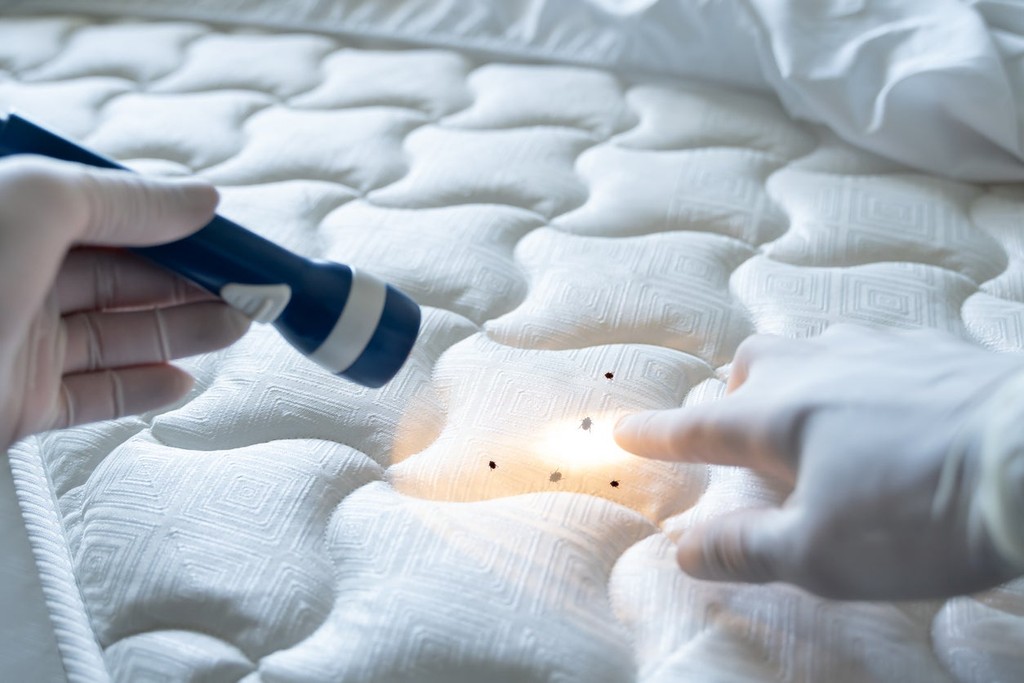Nothing is more comforting than clean, warm, and comfy bedding after a hard day’s work. Nonetheless, bedding can become a nightmare if bed bugs make a home in them. The thought of these bugs in your home is enough to cause sleepless nights.
Scientific research shows sleep deprivation can cause serious health problems like diabetes and blood pressure. This post guides you to detect and remove bed bugs on bedding, guaranteeing a good night’s sleep.
Table of Contents
Can bed bugs get in bedding?
Bed bugs often get into bedding compared to anything else. These bugs habitually feed at night, making your bed and bedding the best hiding spots. Dirty bedding is more likely to get bed bugs compared to clean ones. This is because soiled bedding gives off the scent of a potential host, thus attracting bed bugs.
Blankets and other beddings are bed bugs’ favorite spots because they offer protection. Bed bugs hide from the light, meaning the undersides of your bedding are perfect because they’re often unexposed to it. Your bedding also has several openings that allow bed bugs to hide easily.
If your comforter has a cover, bed bugs will likely enter your bedding through buttons and openings. A basic blanket with a single layer of fabric is less likely to harbor bed bugs. Some of the classic pieces of bedding that get bed bugs when you have an infestation are:
- Comforters
- Sheets
- Blankets
- Quits
- Duvets
- Bedspreads
Common ways bed bugs get into bedding
Bed bugs come into your home by hitchhiking on your belongings. Bed bugs are great hitchhikers, and they are everywhere, including offices, hotels, movie theatres, Airbnbs, and public transportation. Once they enter your home, keeping them off your bedding is impossible.
Bed bugs don’t often get into your bedding by crawling because their range of motion is limited to a 20-foot radius. They will store away on clothing you put on your bed or in areas around it. Some of the common ways bed bugs get into your home and bedding include:
- When you buy used pieces of bedding and bring them home without treatment
- If a friend lends you a blanket, comforter, or duvet, and you take it home to your bed
- If somebody takes a piece of your bedding to their home and brings it back after using it.
Point to note: The best way to prevent bed bugs is to treat any bedding before you use it.
Signs of bed bugs in bedding
Bed bugs are about the size of an apple seed and are visible to the naked eye if they are out in the open. Nonetheless, bed bugs rarely come out into the open, meaning looking for signs of bed bugs is best. It is best to thoroughly search for living bed bugs if you suspect you have bed bugs in your bedding. Here are some of the characters that you should look for:
Bed bug bites
Bed bugs leave marks on your skin when they bite because of the body’s natural response to compounds in their saliva. Bed bug bites resemble bites from common insects, but unlike most, they appear in distinct patterns. You should learn to differentiate bed bug bites on your skin from other bites and skin conditions.
Bed bug statistics also suggest that most people do not experience bite marks. Some people get colossal bite marks accompanied by itching, while others do not get any symptoms due to genetic differences. It is best to keep looking for other signs of bed bugs because no bite marks do not mean you don’t have them.
Blood stains
A bed bug creates a tiny hole in your skin when it bites, but some blood can still come out. You will notice a small amount of blood on your shits, especially white ones. The more likely reason to find blood stains on your bedding is when you squish a bed bug right after it feeds. You can unknowingly squish a bed bug as you toss and turn deep in your sleep. Therefore, it is wise to check everywhere for bed bug remains if you wake up and notice some blood stains on your sheets.
Bed bug feces
Bed bugs feed on blood and excrete like any other insect or animal. Bed bug feces are black and sticky because blood contains iron. When they first pass, the excrements are ordinary liquid droplets, but with time, they dry and turn into tiny dark spots. You will often find these spots on your bed and other furniture. Many dark spots point to a more extensive infestation that needs immediate treatment.
Bed bug exoskeletons
Bed bugs shade their exoskeletons as they grow from one nymph stage to another. You will find these exoskeletons in common hiding spots if you have a bed bug problem.
Using an Ultraviolet flashlight when searching for bed bugs is advisable because their exoskeletons emit a blue light when subjected to UV rays.
Bed bug eggs
Bed bugs reproduce by laying white eggs that appear like tiny rice grains. You are unlikely to find eggs in bedding, such as blankets, comforters, and duvets, but you’ll find them on bed frames and headboards. Pieces of furniture around the bed, such as headlamps, also provide perfect safe spaces for bed bugs to lay eggs.
Musty odor
Bed bugs give off an odor like cockroaches and ants. They give off this scent to let other bed bugs know their hiding spots. Dogs are good at sniffing out this odor.
Treating bed bugs in bedding
The best and easiest treatment for bedding is laundering them in a washing machine and dryer. You must meet some general conditions to ensure that the laundering process delivers the best results in your treatment efforts. Some of these conditions include:
- Bedding such as blankets, duvets, comforters, and sheets must fit in the washing machine.
- The fabric from which the bedding is made should be washable in the washing machine (Some materials, such as wool, cannot sustain the high-temperature settings of the washing machine and dryer)
Caution! Take extra precautionary measures in public Laundromats to avoid getting bed bugs.
It is essential to remember that bedding has different fabrics. The following are treatment guides for various popular materials:
Treating bed bugs in fleece bedding
Fleece bedding is the easiest to wash in a washing machine because it has Polyester that you can launder in high temperatures. This is good because heat is a vital aspect when laundering to treat bed bugs. Follow these steps when laundering fleece bedding:
- Sort out all your bedding and put them in sealed vacuum bags. This is a critical step because it prevents the spread of bed bugs as you take the bedding to the laundry.
- It is also wise to use detergents because they are toxic to bed bugs. Take your bedding out in the laundry room one at a time and put them directly in the washing machine in a high heat setting. Bed bugs and their eggs die at temperatures up to 160° F (70° C).
- Once your laundry is clean, put them in a dryer on a high-heat setting to kill any lingering bed bugs and their eggs. It is also advisable to store clean bedding in vacuum-sealed plastic bags to avoid re-infestation.
Treating bed bugs in wool bedding
Wool is a sensitive vacuum that shrinks in the washing machine if you subject it to high heat. Woolen bedding typically comes with comprehensive washing instructions. However, if washing instructions are unavailable, follow our complete guide for treating bed bugs in wool. Some of the tips you need to adhere to include the following:
- Use a low heat setting.
- Use a gentle detergent to avoid damaging the fabric.
- Wash your woolen items less frequently compared to other materials.
- Soak woolen belongings in cold, clean water before putting them in a washing machine.
Treating bed bugs in electric blankets
Electric blankets pose a considerable challenge when treating bed bugs because you can’t automatically launder them. It is best to check the user manual to confirm if they are washable and how to wash them if possible. Effective and safe bed bug treatment methods for unwashable items are limited. You can use steam to treat them or essential oils that kill bed bugs. If the infestation is massive, you must dispose of your electric blanket.
Final Thoughts
Bed bugs are challenging to kill due to several reasons. You can only get rid of bed bugs by treating your entire home, not just the bedding. Several safe and effective treatment options can help you achieve a 100% bed bug-free home. More importantly, it would be best if you took proactive measures to prevent bed bugs in your home by following these tips:
- Take steps to avoid getting bed bugs in hotels and other public spaces.
- Install bed bug monitoring tools in your home.
- Use bed bug traps, especially in high-risk spots in the house.
- Vacuum your home as frequently as possible.
- Use essential oils to repel bed bugs.
FAQs
Do bed bugs like blankets?
Bed bugs like blankets and other pieces of bedding because they are as close to a host as possible.
Can bed bugs bite through bedding?
Bed bugs can get inside blankets, comforters, duvets, and other bedding through openings but cannot bite through them.
Do bed bugs lay eggs in bedding?
Bed bugs are unlikely to lay eggs in bedding because they prefer places where the eggs are safe and undisturbed.
Can bed bugs live in stored bedding?
Bed bugs can live in stored bedding such as duvets, comforters, blankets, sheets, et cetera. You should store clean bedding in vacuum-sealed plastic bags to avoid contamination when your home has bed bugs.

